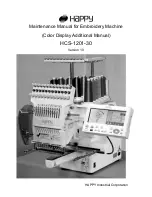
4
OWNER’S MANUAL
Fog Droplet Size
It is important to adjust fog droplet size properly for your application. Larger
droplets are better for dust control, humidification and sanitizing. However,
large droplets settle faster, and heads must be closer together to get even
coverage.
Small particles are better for such “air mix” applications as odor control and
ULV (ultra low volume) pest control; they float extensively, have a large
surface area and evaporate quickly.
A metering valve (drawing, p. 5) controls the droplet size of each head’s out-
put. Close the valve (turn clockwise) for smaller droplets. Too high a pressure
in the liquid feed line will make it harder to adjust for smaller droplet sizes.
Install a step-down pressure regulator (see “Theory of Operation”) to solve
this problem.
“Fine-Tuning” The System
Some experimentation is usually needed to obtain best results at the lowest
operating cost. This typically involves three factors:
1. Head Location.
Fog heads should be placed where they are needed, and
spaced for uniform coverage. To move a head, or add a new one, just mount
it where needed, plug into an electric outlet, and attach a liquid feed line.
2. Droplet Size.
We recommend starting with a large droplet size, then mov-
ing to smaller droplets as needed to increase diffusion and penetration, or to
reduce wetting and fallout.
3. Fog Cycle Time.
Most fog installations run intermittantly, using an interval
timer to turn on a liquid feed pump or activate a solenoid valve. After
determining an effective droplet size, gradually shorten the ON cycle time (or
lengthen the OFF cycle time) to reduce liquid consumption and motor wear.
Keep reducing fog output until you find the point of maximum control at
minimum cost. You may have to adjust fogging cycle times to compensate for
seasonal temperature changes.
CONTINUOUS OPERATION
If your fogging system must operate continuously, use the smallest
droplet size that does the job. This will minimize liquid discharge
and chemical expense.
Be aware that continuous operation means faster wear on motor
brushes. (Typical brush life is 650–700 hours — about one month at
24 hours a day, 7 days a week.)


























